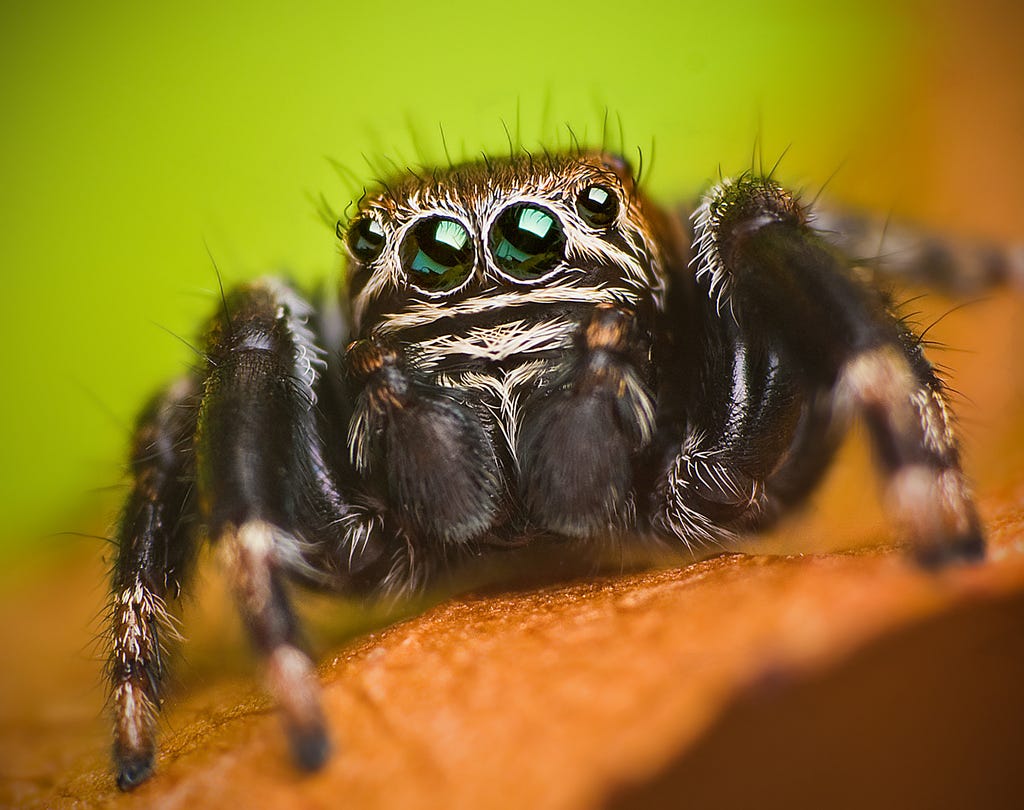One thing I love about science is that you can never be complacent. Just when you think you have a thing figured out, and all available data makes perfect sense, your understanding can suddenly and unexpectedly be challenged by new evidence. Science is all about approximating truth, but never knowing if or when you are completely correct. Science deals in hypotheses, not absolute knowledge; generalizations about the world are always subject to repeated testing and the possibility of being shown wrong. Even long-held views can suddenly be turned on their heads with a single observation.
The spider family Salticidae includes about 6,000 species known as jumping spiders. They are noted for having among the best vision of any arthropod. They have four pairs of eyes on a forward-directed, more or less flattened face. The anterior-median eyes are especially large. These spiders are diurnal, active by day, generally walking around slowly. But they are capable of making sudden, truly impressive leaps. They vary in size from about 1 mm to as much as 25 mm, or one inch. They do not build webs like many other spiders, but they do make silk. As they move around the environment, they attach a silk filament to the substrate like a safety line, so if a jump fails, such as a pounce toward a prey item, they can simply climb the line back up to where they started. Some species have elaborate courtship dances, with males displaying plumose hairs, sometimes iridescent and brightly colored.
Taxonomy is fundamental science in its purest form. Curiosity driven and agenda free, it is a joyful exploration of the diversity and history of species for its own sake. Like the reason mountaineers climb, taxonomists are driven to discover and understand the attributes of species, and their evolutionary origins, simply because they are there. When a new species is named, there is rarely an expectation of any practical importance attached to the discovery beyond expanding our knowledge of life on earth. Yet, in the fullness of time, there is no way to predict if or when even the most obscure species might suddenly emerge to play some transformative role in research or otherwise become valuable to science or society.
A recent case in point is a little jumping spider named Evarcha arcuata. When the Swedish arachnologist Carl Alexander Clerck named the species in 1757, in the first comprehensive treatment of Swedish spiders, titled Svenska Spindlar, he could not have imagined that this spider would one day challenge the limits of our understanding of REM sleep.
Photo by Lukas Jonaitis from Vilnius, Lithuania. CC BY 2.0. https://creativecommons.org/licenses/by/2.0/deed.en
These spiders are quite small at 6-8 mm, with females reaching the larger sizes. Females have a brown and whitish cephalothorax — in spiders the head and thorax are fused into one functional body segment —and an opisthosoma with a pattern of diagonal black spots, sometimes outlined in white. Males are nearly black with a copper-toned gloss, and a face with horizontal black and white stripes. But its appearance is no longer all that sets this little spider apart.
Until now, rapid eye movement, or REM, sleep has been associated with vertebrate animals, especially mammals and birds. Although all spider eyes are fixed and cannot move like ours, jumping spiders have internal retinal tubes that move to direct their gaze. In young spiderlings, movements of these retinal tubes can be seen through a yet unpigmented, translucent exoskeleton. A team of scientists, led by Daniela Rößler, a postdoctoral fellow in the University of Konstanz, have observed bouts of retinal tube movements of regular intervals and durations that increase through the course of a night. These REM-like behaviors are linked, also, to twitching movements of their legs, reminiscent of those seen in sleeping dogs. All of this raises fascinating new questions about the nature of sleep, who sleeps, and even the possibility that dreaming could exist in invertebrates.
I am not yet convinced that spiders dream, but then no one had ever thought to ask one until now. Maybe the coordination between retinal tube and appendage movements is some kind of practice of muscle coordination important to the spider’s development and survival. Or maybe, just maybe, these baby spiders are reliving their day’s exploits as they sleep. Whether spiders really dream, or this is just an idea dreamed up by scientists, it is exciting, challenges what we thought we knew about sleep, and is definitely worth pursuing.
The scientists who made this remarkable discovery note that it would be possible to control completely what baby spiders see in their waking hours, then observe whether similar patterns are expressed during their REM sleep, indicating whether they are having visual dreams or not. I look forward to the results of such experiments.
If you would like deeper insights into this story, the study was reported in a recent article in the Proceedings of the National Academy of Sciences. In addition to details about their observations, the authors present videos showing both retinal tube and appendage movements that are absolutely fascinating to watch.
So, to baby jumping spiders everywhere, I bid sweet dreams.
Further Reading




